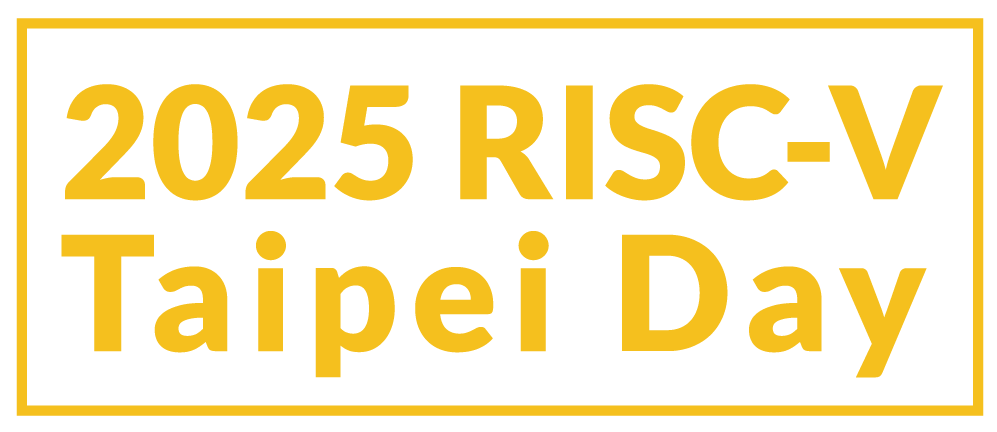Pioneering AI with RISC-V – Built on Open Standards, Secured for Tomorrow
隨著 AI 計算需求爆發,RISC-V 架構標準化與 AI 加速器(NPU、TPU)整合將提升效能,使 RISC-V SoC 可支援 AI 超算、優化訓練與推理,並強化邊緣 AI 運算,減少對雲端依賴,提高隱私與安全性。此外,RISC-V 開放架構允許開發者檢視晶片設計,降低安全漏洞風險,並可依需求擴充安全模組,增強防護能力。
RISC-V 具備開源與靈活客製化優勢,推動 AI 在雲端、邊緣 AI、自駕車、智慧醫療、AIoT 等領域的應用,並促進技術民主化,加速全球創新。台灣 RISC-V 聯盟 也將持續推動開源 AI 硬體與軟體生態,帶動 AI 晶片設計發展,共同見證 RISC-V 開創 AI 與安全運算新紀元。
RISC-V Pavilion @ COMPUTEX

Location: L0425, 4F, Nangang Exhibition Hall 1
RISC-V Conference

Location: Room 505, 5F, Nangang Exhibition Hall 1
精彩議程
報到與入場
Welcome Keynote:
Make RISC-V Popular in Taiwan for the World
林志明|台灣RISC-V聯盟 會長, 晶心科技 董事長暨執行長
Welcome Remark
王其國 博士 | 台灣物聯網產業技術協會 理事長
Welcome Remark
巫建恒 | 數位發展部數位產業署簡正
Group Photo
RISC-V - To boldly go where no ISA has gone before
Lu Dai | Board Chair, RISC-V International | Senior Director of Technical Standards, Qualcomm Technologies, Inc.
We have built a thriving ecosystem with growing membership and a maturing, complete architecture. But where do we go from here? The possibilities are boundless—custom silicon, vertical integration, AI-driven innovation, enhanced security, and full-stack solutions that redefine computing.
To get there, we must remain customer-focused and developer-first, ensuring RISC-V continues to break barriers. Join us as we explore the future of an ISA designed not just to compete but to revolutionize. The journey has just begun.
Tech Talk 1
蘇泓萌 博士 | 晶心科技 總經理暨技術長
In this talk, we will discuss four key elements in modern computing: namely AI/ML Accelerations, Embedded and Real-Time Processing, Safety and Security, and Application Processing. We will then show how the RISC-V architecture and ecosystem address them, using Andes solutions as examples.
Tech Talk 2
Luke Yen | Fellow of RISC-V CPU and Machine Learning Architectures
Tenstorrent
Together, these technologies represent a unified hardware-software strategy to support ubiquitous AI computing. They position RISC-V as a competitive, open alternative to proprietary architectures, ready to power the next generation of AI-enabled and automotive systems. This presentation underscores the role of openness, scalability, and performance in shaping the future of personalized and distributed intelligence through high-performance RISC-V platforms.
Skymizer HyperThought : Hyper-threading Language Processing Units for Large Language Model
唐文力 | 臺灣發展軟體科技股份有限公司 創辦人暨技術長
Lucky Draw
Lunch Break
報到與入場
透過開源協作釋放 RISC-V 的潛力
蔡傳資 | Chair of System Library Working Group, RISE
本次演講將介紹 RISE 計畫,一項旨在推動開源軟體的創建、優化和上游化而令人興奮的合作。這些軟體將會被 RISC-V 生態系統有效地利用。 我們相信,RISC-V 為亞洲公司、尤其是台灣公司企業提供了絕佳的機會。透過硬體和軟體層面的創新,為客戶提供更高的價值。 本演講將討論一些具體範例,展示如何將為特定目的優化的硬體與開源技術結合,解鎖 RISC-V 的所有潛力,為未來鋪設由開放、協作和前瞻性技術所定義的道路。 為開放、協作和前瞻性技術定義的未來鋪平道路。
RVA23 設定檔和平台規格對推動 RISC-V 生態系發展的重要意義
Mark Hayter |Rivos Inc. 共同創辦人兼首席策略官
RVA23 設定檔引入了重要功能,包括 Vector 和 Hypervisor 擴展,旨在滿足高效能運算的需求。 Vector 擴展增強了 RISC-V 的平行資料處理,有利於機器學習和科學計算等工作負載。 Hypervisor 擴充功能支援伺服器虛擬化,支援可擴充且安全的雲端基礎架構和企業應用程式。
RVA23
設定檔的一個核心優勢是確保各種硬體實現的軟體相容性,從而能夠分發可在不同的 RISC-V 供應商之間運行的二進位套件。這對於 Linux 發行版(如 Ubuntu、RHEL)和 Android 尤其有用,其中應用程式以適用於所有用戶的二進位形式下載。 RVA23 設定檔定義了編譯器可以安全地為所有實用進行編譯的指令集。
完全啟用 Linux
發行版需要確定平台規格所提供的硬體和韌體功能。伺服器平台規格不僅描述了對 RVA23 設定檔的需求,還描述了伺服器 SoC 規格中的硬體需求以及引導和執行時間服務規格中的韌體詳細資訊。
對於開發 64 位元伺服器處理器的公司來說,採用 RVA23 設定檔和伺服器平台規格可確保一致的軟體分發、相容性和高效能。
Revolutionizing AI Computing with World's First RISC-V 50 TOPS AI PC
Yuning Liang | Founder & CEO, DeepComputing
At CES 2025, Nvidia showcased the future of AI-powered laptops with its GeForce RTX 50 Series, pushing AI-driven graphics and processing to new heights. Yet, a new frontier is emerging—RISC-V AI computing—ushering in an open, customizable era for AI hardware.
DeepComputing is leading this shift by developing the world’s first RISC-V 50 TOPS AI PC. This revolutionary device is built in collaboration with Framework, RISC-V SoC manufacturers, open-source OS leaders Canonical and Fedora, and AI innovators utilizing DeepSeek LLM models—powering AI applications like VLC Media Player and beyond.
This session will uncover how DeepComputing’s AI PC harnesses the open-source flexibility of RISC-V, enabling vertically optimized AI ecosystems. We’ll dive into the dual-die AI SoC architecture, the 64-bit RISC-V CPU with out-of-order execution, and how the system accelerates AI workloads—delivering faster inference, seamless AI app integration, and cloud-free AI experiences. Join us to explore how RISC-V + AI is not just a technological leap but a movement—pioneering a future of modular, sustainable, and developer-empowered AI computing.
RISC-V accelerating the future of AI & Automotive computing
Nathan Ma | AVP of Marketing and Strategy, Nuclei System Technology
As a leading RISC-V processor IP provider, Nuclei's RISC-V products have been adopted across diverse applications, from AI accelerators to automotive MCUs/SoCs. Nuclei is the world's first RISC-V IP company to achieve ISO26262 ASIL-D product certification. This achievement not only validates our technological capabilities but also demonstrates RISC-V's readiness for the most demanding safety-critical applications.
In this presentation, we will share our hands-on experience in developing and deploying RISC-V solutions for AI and automotive applications. We'll provide in-depth technical insights into:
- Our RVV1.0 vector extension implementation supporting up to 1024-bit VLEN & DLEN, optimized for the offloading of specific AI layers or operators
- We'll also share some successful cases in both AI acceleration and automotive computing.
以 RISC-V 架構打造 AI 與後量子安全融合的自主機器人平台
池明洋 | 池安量子資安股份有限公司 創辦人&董事長暨執行長
Enabling NPU AI Compute entirely on RISC-V ISA
Roger Espasa | Founder & CEO, Semidynamics
Semidynamics' novel approach eliminates this issue by introducing a RISC-V ISA-only, performance-optimized compute engine that integrates CPU, vector, and tensor operations into a single compute element. This innovation enables RISC-V to enter the previously unaddressed NPU marketplace. With configurable performance ranging from 8 to 64 TOPS, this RISC-V engine delivers efficient AI acceleration for LLMs, deep learning, edge AI, and datacenters.
Panel Discussion
主持人:
曲建仲 博士 | 知識力科技 執行長
與談人:
Frankwell Lin | Chairman, RISC-V Taiwan Alliance
Lu Dai | Board Chair, RISC-V International | Senior Director of Technical Standards, Qualcomm Technologies, Inc.
Dr. Charlie Su | President and CTO, Andes Technology
Luke Yen | Fellow of RISC-V CPU and Machine Learning Architectures, Tenstorrent
William Wei | CMO and EVP, Skymizer



































